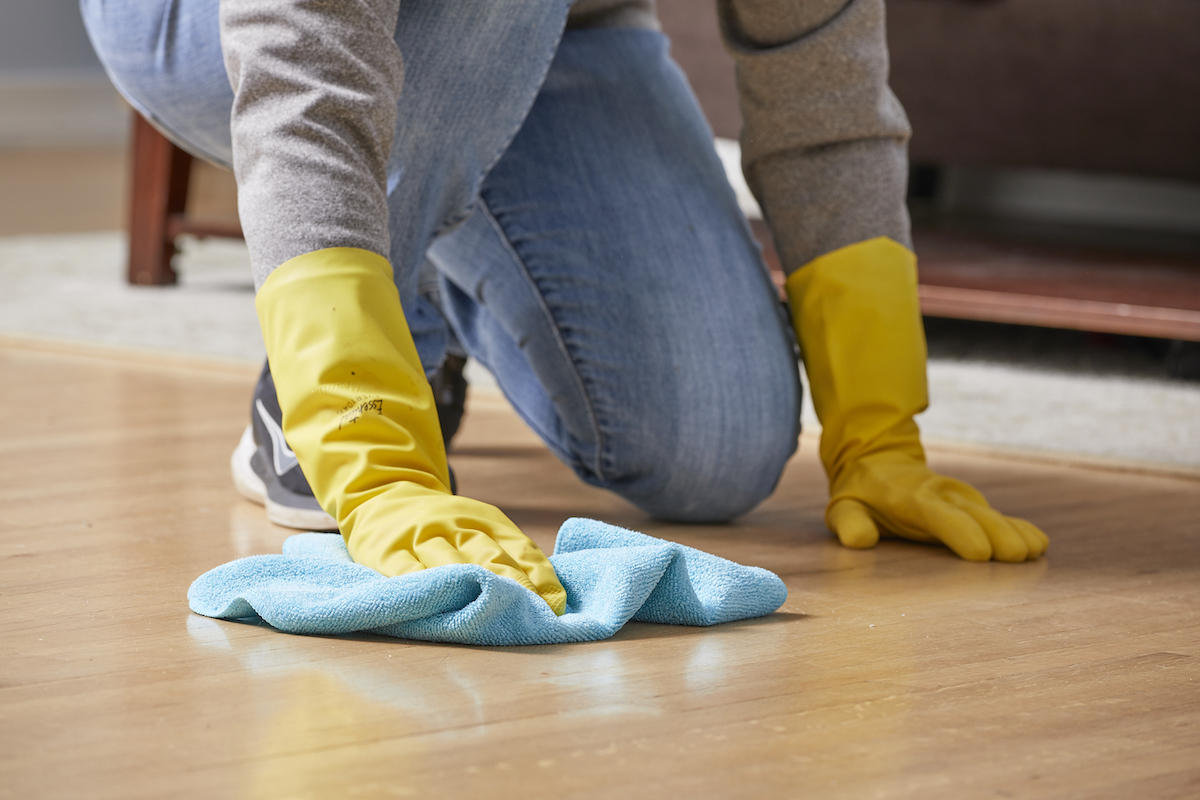We may earn revenue from the products available on this page and participate in affiliate programs. Learn More ›
Q: I have never given much thought to cleaning my cherry wood floor, but I’m starting to notice how dingy it has become. What’s the best way to clean hardwood floors? I’d love recommendations for wood floor cleaning techniques, and a good hardwood floor cleaner.
A: It’s true, regular cleaning is a must to maintain hardwood floors. Because different floor finishes have unique care requirements, the best way to clean hardwood floors will depend on the type of finish rather than the wood species (e.g., cherry, maple, or oak). If you use the wrong method or cleaner, you could damage the wood.
Read on to learn how to identify your floor’s finish and select supplies for dusting, deep cleaning, and removing stains. Using these recommended techniques for the best way to clean hardwood floors will keep yours looking great for years to come.
First, figure out what kind of finish your floor has.
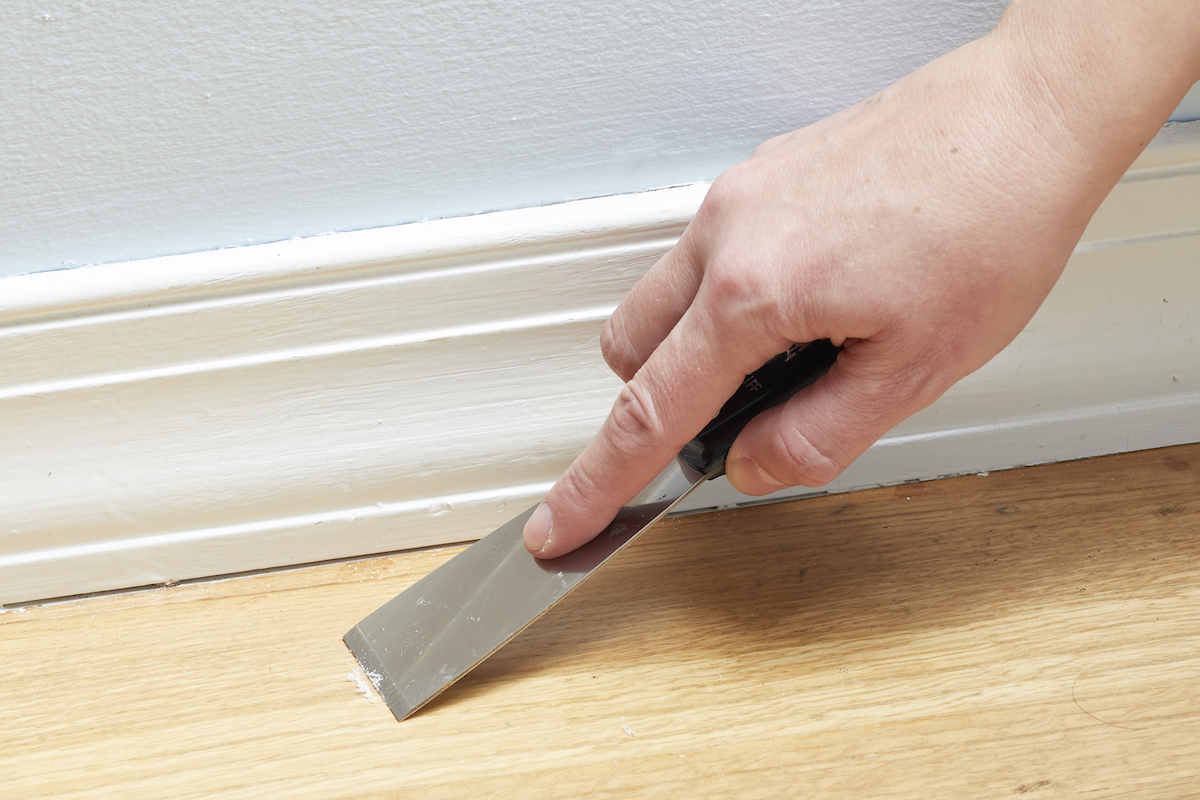
There are two main types of hardwood floor finishes: surface finishes and penetrating finishes.
- Surface finishes such as urethane and polyurethane form a protective, waterproof barrier on the surface of the floor. When liquids come into contact with surface finishes, they pool rather than penetrate the wood. It’s safe to use water and water-based cleaning products on surface finishes.
- Penetrating finishes such as linseed or tung oil soak through the surface of hardwood floors and then are usually topped with a wax coat for added sheen. These finishes easily absorb water, and water can warp wood floors. Use only solvent-based cleaning products instead of water-based ones on floors with penetrating finishes.
The easiest way to check if a floor has a surface finish is to take a sharp knife blade to a small, hidden area of the floor and scrape off a tiny amount of finish. If the scraped material is clear, your floor probably has a surface finish. If scraping the floor finish smudges it, but no clear material comes away, the floor likely has a penetrating finish.
Bust dust by mopping, sweeping, or vacuuming regularly.
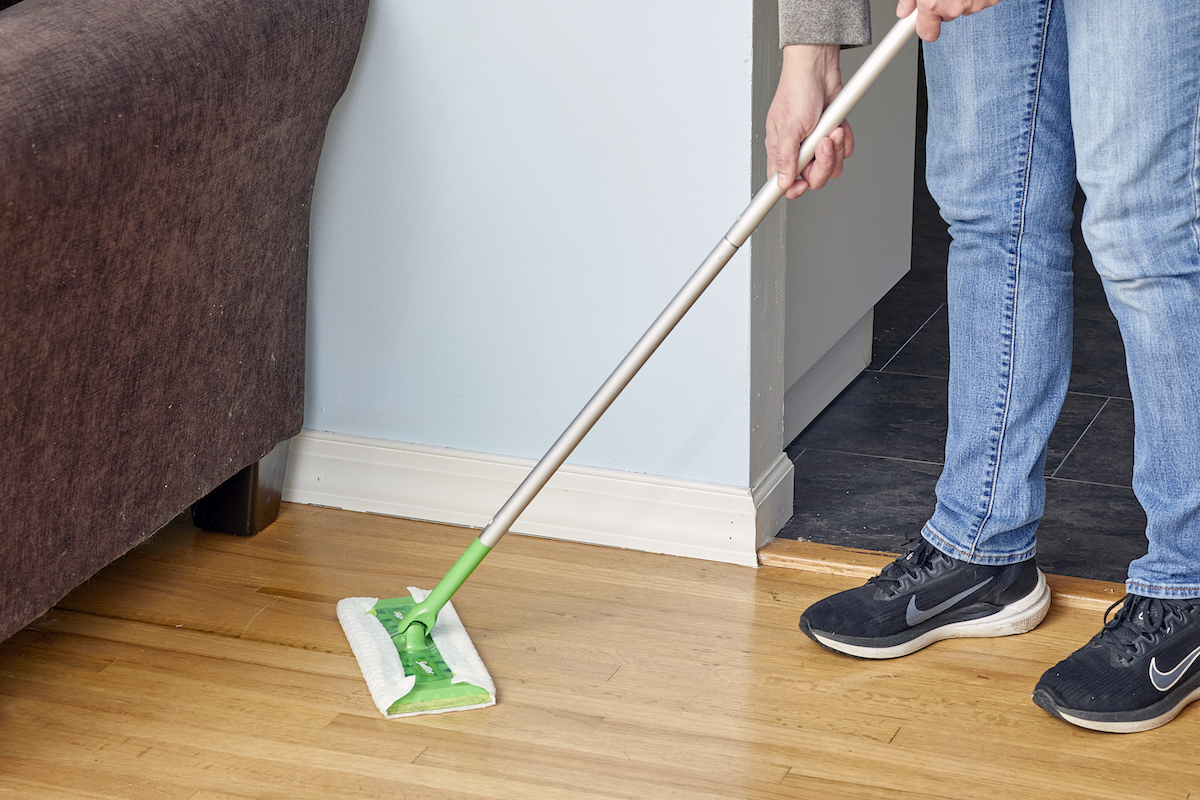
Dry mopping, sweeping, and/or vacuuming on a weekly basis are the best ways to rid hardwood floors of light dust, dirt, and pet hair accumulation. This routine works on floors with either surface or penetrating finishes.
The best mop for wood floors is usually one with a large, flat head affixed with a microfiber cloth pad, such as the Swiffer Sweeper. These mops have pads with tiny synthetic fibers that reach into the grooves of wood floors to pick up and hold dust without scratching the wood.
To keep costs down and lower your environmental impact, choose pads that can be removed, machine washed, and reused. Compatible on a variety of hardwood floor mop brands, a pair of reusable pads like the Old Home Kitchen Mop Pads costs less than $15.
If you prefer to sweep rather than mop, opt for a broom with synthetic fiber ends to help trap collected dust in the broom head and prevent it from resettling on the floor.
If your preferred mode of dust busting is vacuuming, use a floor-brush attachment and avoid the beater bar—its rotating brush can dent wood floors. Move your cleaning tool from one side of the floor to the other, paying extra attention to areas where adjacent floor boards meet. These nooks are hiding spots for trapped dust.
Scrape off food stains.
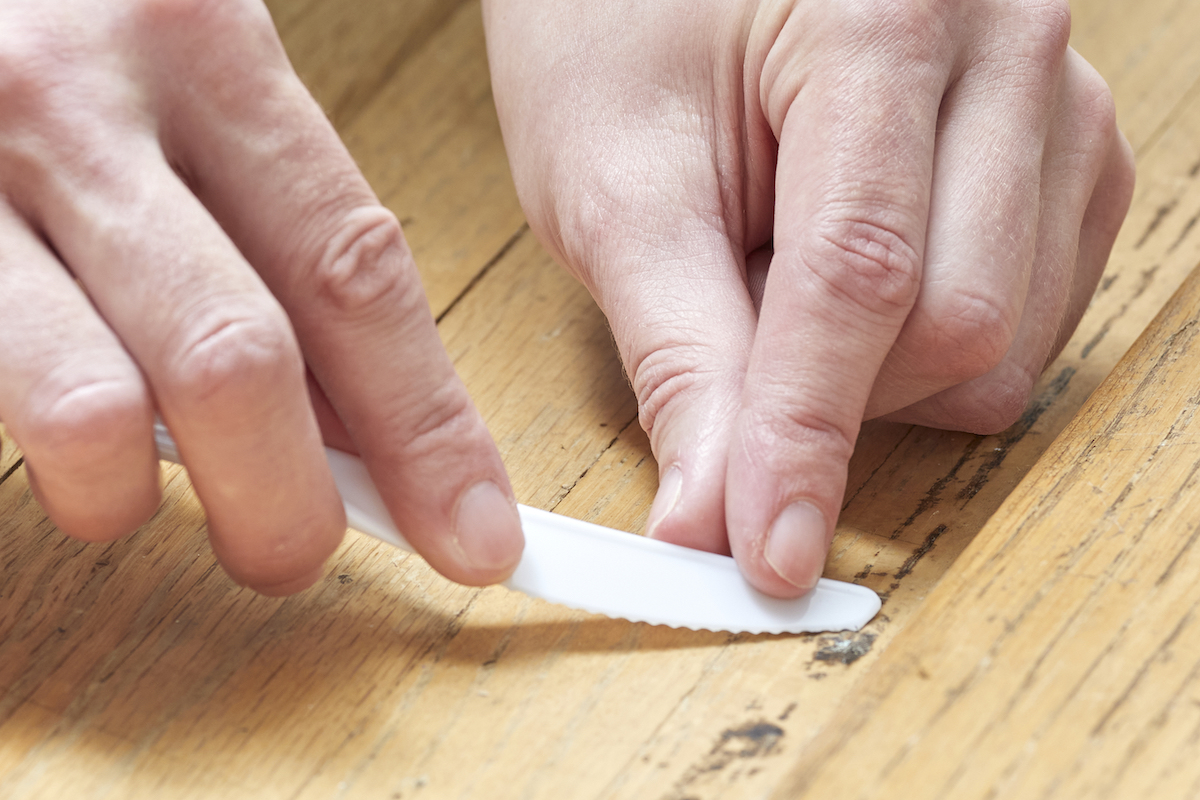
Remove caked-on food by carefully inserting the tip of a plastic knife under the lower edge of the debris and then gently sliding the knife upward. Rub the scraped spot with a clean cloth slightly dampened with a few drops of water, then make a second pass with a dry cloth to dab up the water.
If using this technique on a floor with a penetrating finish and a small section of the wax coat gets stripped by the knife, reapply a dollop of the hardwood floor wax to the area with a soft cloth, buffing it in to render the area shiny and spotless.
Fight oil stains with TSP.
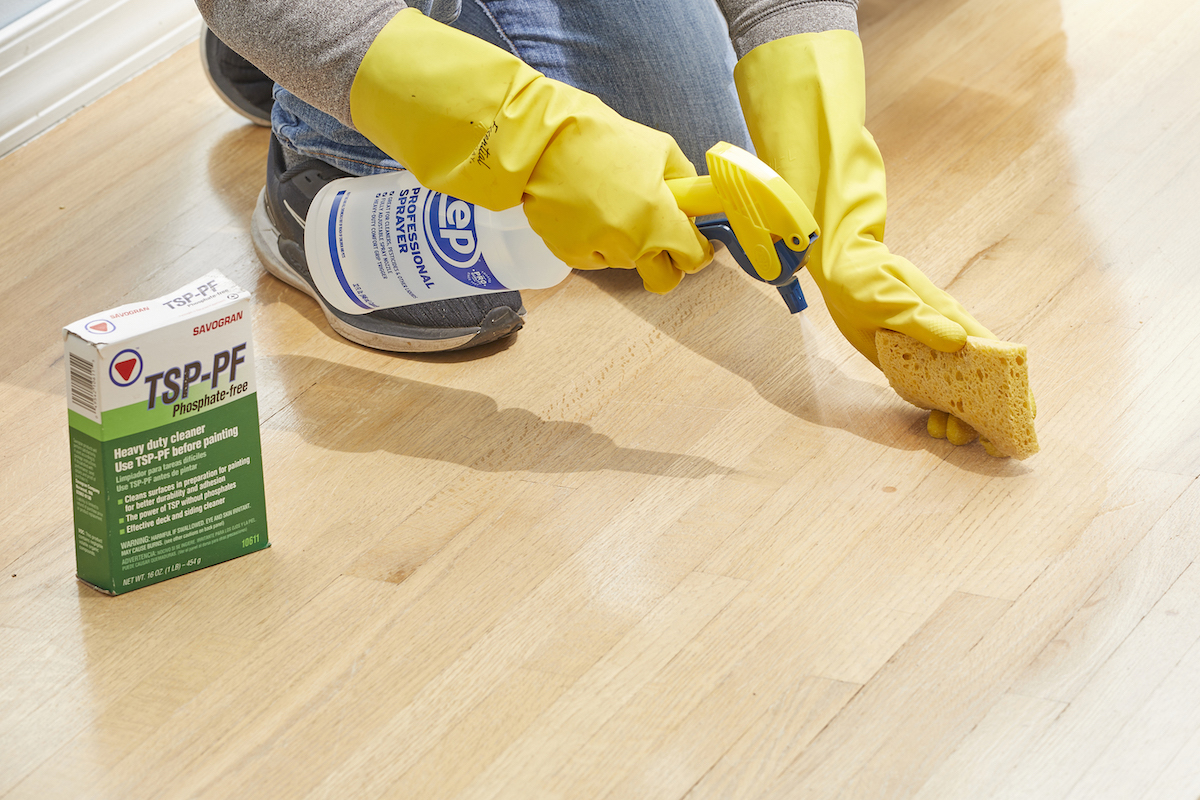
Oil and grease stains on floors with surface or penetrating finishes easily break down when exposed to trisodium phosphate (TSP). Don protective gloves and safety glasses, and dilute 2 tablespoons of TSP in 1 gallon of warm water in a large bucket. Dip the tip of a clean cloth into the solution, then use gentle circular motions to work it into the stain. Once the TSP dissolves it, run a water-dampened cloth over the area to sop up the TSP, then quickly dry the area with a clean cloth.
Ice out wax and gum.

Dried candle wax, crayon marks, and chewing gum on floors with surface or penetrating finishes can easily be removed with ice. Fill a Ziploc freezer bag with a few ice cubes, place the chilled bag over the buildup until it becomes brittle, then scrape it off with the edge of a plastic spatula.
If the spatula removes the protective wax from a floor with a penetrating finish, use a soft cloth to reapply a solvent-based hardwood floor wax to the scraped area, then buff it into the repaired area with the cloth.
Scrub water, ink, and pet stains well.
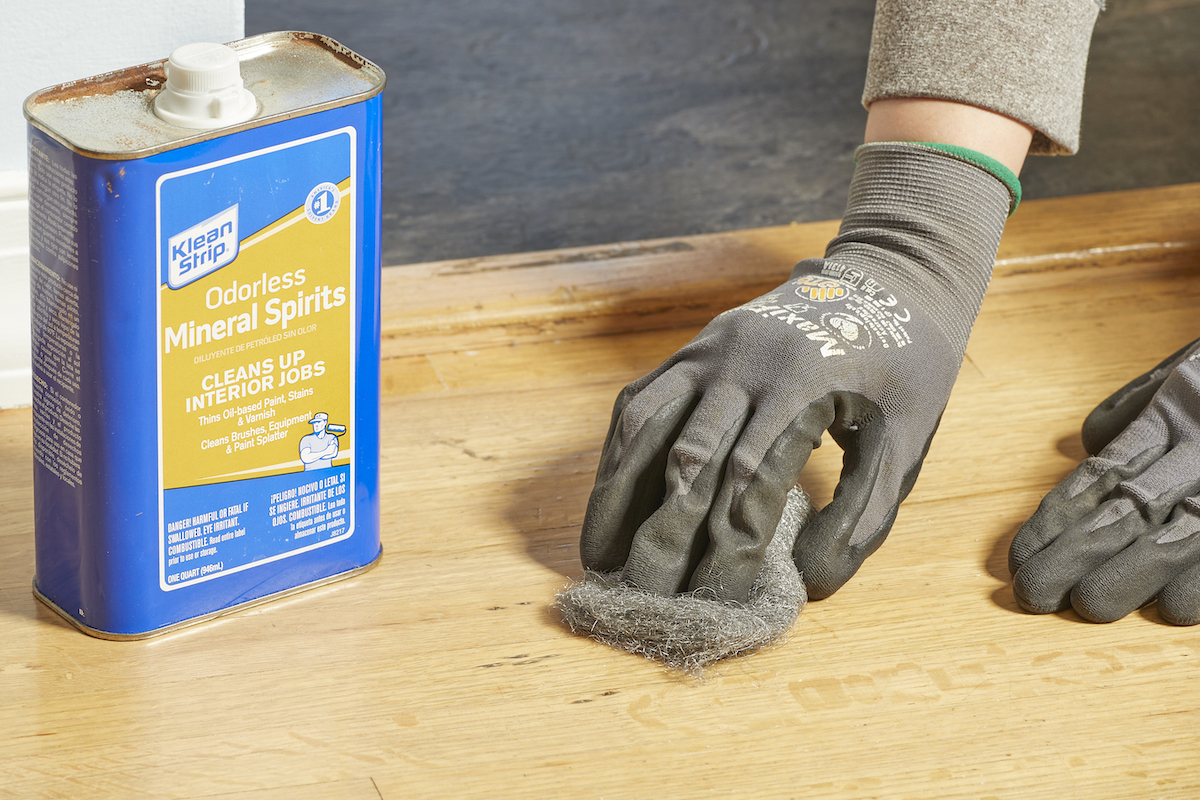
Spots left by water, ink, or pet urine are some of the most stubborn stains. For floors with penetrating finishes, it’s best to tackle these stains with the following steps using only an appropriate hardwood floor cleaner and a scouring pad designed for a penetrating-finished floor.
- Remove the spots from floors with penetrating finishes by lightly sanding the stain with extra-fine sandpaper.
- Gently scrub with a coarser “00” grade steel wool wet with mineral spirits.
- Wipe away the mineral spirits with a damp cloth, then use a dry cloth to remove the water.
- With a soft cloth, apply a solvent-based hardwood floor wax to the scrubbed area and buff it in to restore its shine.
Deep clean the floor with a quality hardwood floor cleaner.
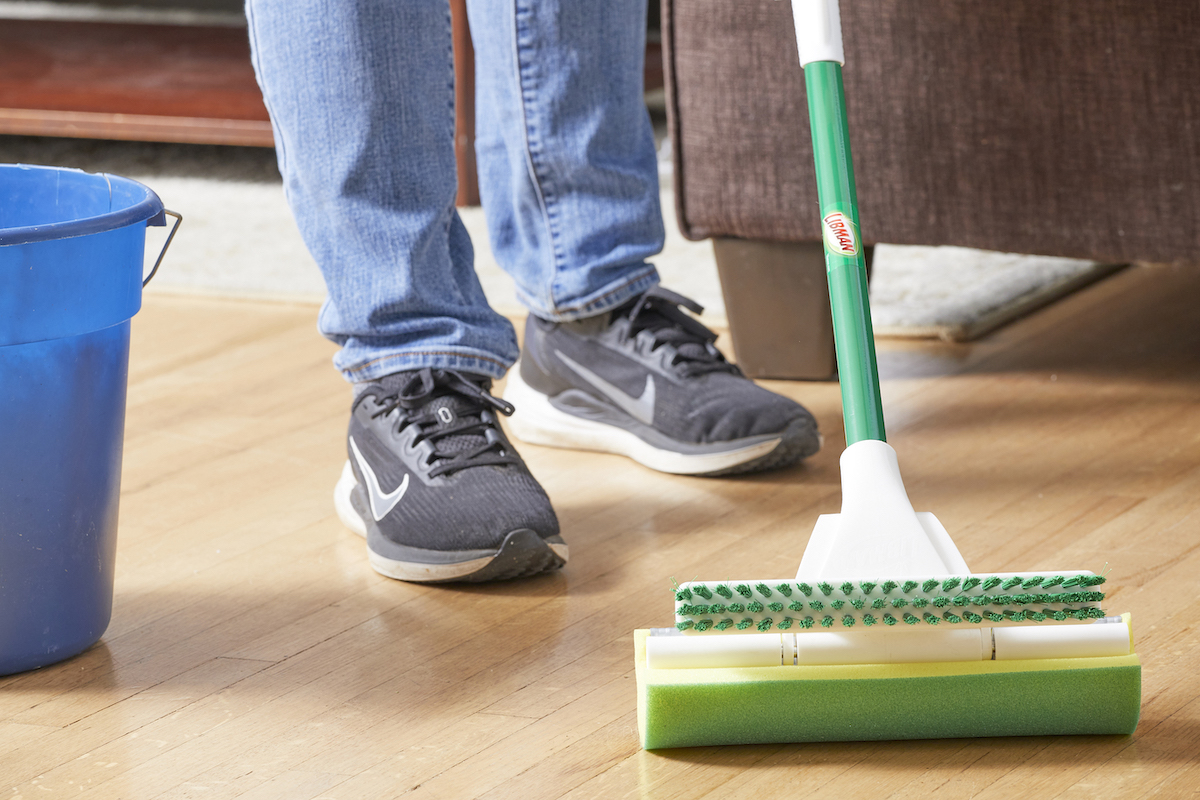
The type of wood floor cleaner that’ll work best for your floors depends on the floor’s finish.
If a surface-finished hardwood floor still looks dingy or dull after dusting, deep clean it with any pH-neutral, wax-free, and petroleum-free cleaner, such as Bona PowerPlus Hardwood Floor Deep Cleaner, or a homemade solution comprising ¼ cup of dish soap and 1 gallon of warm water.
The best way to mop wood floors with a surface finish starts with saturating a sponge mop with the cleaner, wringing out the excess liquid until the mophead is damp but not dripping, and then mopping 3-foot sections of the floor at a time using circular motions to draw out dirt and grime. Then, rinse the mop in clean water, wring out the excess, and damp mop the floor again to soak up lingering cleaner. Use a soft, clean cloth like the AIDEA Microfiber Cleaning Cloths to dry the floor.
If your floor has a penetrating finish, the best way to deep clean it is to strip away the grimy old wax coat and reapply a fresh wax coat. Rub a clean cloth saturated in mineral spirits over 2-foot sections of the floor at a time, letting the mineral spirits dwell for 5 minutes on each section before wiping away with a fresh cloth dampened slightly with water. Then, dry thoroughly with a fresh, dry cloth.
Finally, apply a solvent-based hardwood floor wax, such as Trewax Paste Wax, with a soft cloth. Use the amount the manufacturer recommends. Then use the cloth or an electric polisher (buy one or rent one at a hardware store) to buff the wax in circular motions, polishing in 2-foot sections at a time.
Perform the appropriate deep-cleaning routine on a biannual basis, whether you see grimy buildup or not. It can be hard to notice gradual changes on a floor you walk on every day, but after it’s clean you may be impressed by the difference.
Final Thoughts
When looking for the best way to clean hardwood floors, first determine the type of finish on the floors. The type of finish determines the kinds of cleaners and methods that will safely help clean the floor. While a good deep cleaning can help restore the look of wood, it’s usually only necessary a few times each year. In between, regularly mopping, sweeping, and vacuuming can help maintain the finish and keep floors looking their best.
FAQs
Using a hardwood floor cleaner made with white vinegar can help with cleaning heavily soiled hardwood floors. It’s important to dilute the white vinegar, using ½ cup of white vinegar for every gallon of water, as it can be too harsh and damaging on its own.
Deep cleaning old hardwood floors is very similar to cleaning newer floors. Choose a method and cleaner that’s made to clean wood floors with the same type of finish. However, it’s important to test a small area and go slowly, as the wood may need some small repairs or have damage that’s only visible up close.
Dr. Bronner’s is a pure castile soap that is safe on wood if it’s diluted. To make your own homemade wood floor cleaner, add just a few drops to a spray bottle filled with water.
Microfiber padded mops are great for surface dirt, but ground-in dirt may require the use of a plastic knife to scrape out dirt, a vacuum attachment to pull it out, or light sanding if it’s truly trapped in the wood.
There are a lot of reasons wood floors seem dirty after mopping. Make sure to rinse the mophead thoroughly and often, as a dirty mop can’t attract new dirt it encounters on the floor. Also, swapping out mopheads can help when dealing with very dirty floors. To find out if the floor is clean, wipe a white cloth over newly mopped areas to see if the floor is still dirty.

